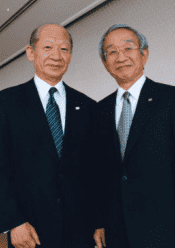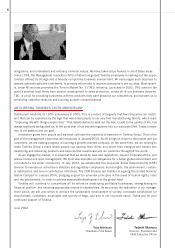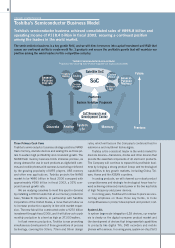Toshiba 2004 Annual Report Download - page 14
Download and view the complete annual report
Please find page 14 of the 2004 Toshiba annual report below. You can navigate through the pages in the report by either clicking on the pages listed below, or by using the keyword search tool below to find specific information within the annual report.
12
Increasing Profitability in the Digital Products Business
and Developing Growth Engines
Toshiba is developing its business to build a rapidly expanding
group able to generate and sustain profitable operations.
Yet in less than a year, Toshiba’s key markets have undergone dramatic shifts, including faster than anticipated
growth in demand for digital consumer electronics and appliances. Recognizing this, Toshiba Group used the
opportunity of the new fiscal year to define a new business plan, one primarily concerned with reconstructing the
growth strategy. Achieving the targets of the new plan will raise the value of Toshiba by securing high profit and
sustainable growth.
Restructuring the Portable PC Business
Tumbling product prices, particularly in the first half, cou-
pled with price increases in major components, resulted in
an operating loss of ¥22 billion for the portable PC and
peripherals business in fiscal 2003. We responded with
urgent, wide-ranging restructuring measures that will re-
build the portable PC business and contribute to increased
profits. Steps taken in the second half to strengthen com-
petitiveness include cuts in headcount both in the domestic
market and overseas that have allowed us to improve the
efficiency of the sales structure; a reduction in PC plat-
forms to improve development efficiency and promote a
review of product strategy; and increases in overseas pro-
duction and ODM (Original Design Manufacturing).
Another major move to accelerate reform was implemented
in January 2004, when the portable PC business became a
new in-house company, the Personal Computer & Network
Company. We are already starting to see positive results
from these efforts: losses in the PC and peripherals busi-
ness bottomed out in the second quarter of fiscal 2003 and
have since started to recover.
In the future we will end mass production at Ome
Operations, repositioning these facilities as a product de-
velopment and experimental production base. This move,
in tandem with an increase of ODM to over 50% by the end
of March 2005 will enhance production efficiency. Fixed
costs will be cut by transferring employees to growth sec-
tors, and development costs will be reduced by decreasing
the number of motherboards and increasing use of com-
mon parts. The cost structure of low-end models will also
be improved and made more competitive, a move that rec-
ognizes that they have become commodity products.
¥1,000 billion
(cumulative total through FY06)
Focusing on digital
products and
electronic devices
businesses
Capital
Investments
¥1,100 billion
(cumulative total through FY06)
To strengthen digital
products and semiconductor
partnerships
R&D
Expenditures
ROE
Over10%
Net Sales
¥6,200 billion
Operating
Income
¥280 billion
Overseas
Business
Ratio
50%
Debt-to-Equity
Ratio
100%
Fiscal 2006 Targets (consolidated)
PROFITABLE GROWTH
























